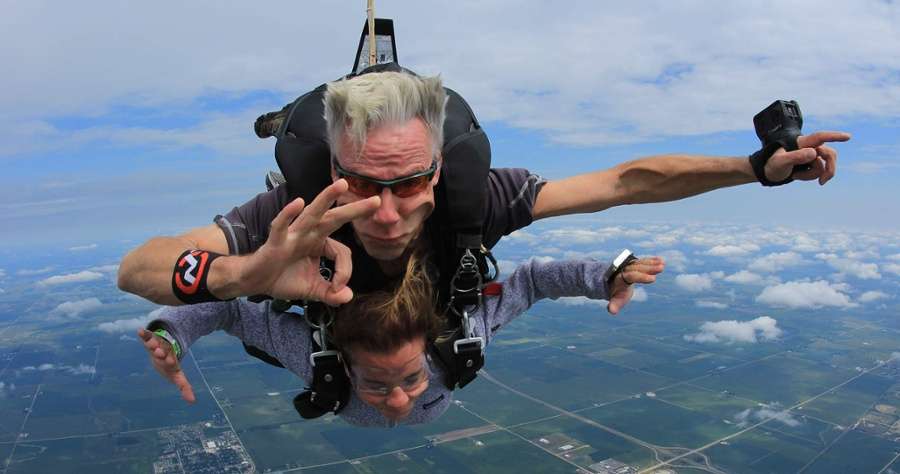First-time freefallers are often cautious to take the great plunge out of an airplane. That’s why before committing to the adventure, many find themselves on Google searching things like “how safe is skydiving” to calm their nerves.
If that’s how you found us, you’re in luck! We’re here with the facts you were looking for to prove that skydiving is far safer than you might think.
Let’s look at how skydiving stacks up against other high-risk sports and share a few important safety features about skydiving gear and training:

What Determines a Sport’s Safety?
Safety is bucketed into two general categories: injuries and fatalities. Often, a sport can be dangerous and lead to injury because of lack of education about proper safety precautions, low quality or lack of equipment or environment. With this in mind, few sports are inherently unsafe, rather, people who face harm often aren’t following safety rules properly.
How Skydiving Stacks Up Against Other Extreme Sports
Let’s compare some of the riskiest sports to skydiving to bring you back down to earth on the true dangers of skydiving:
Boxing
In the boxing ring, you’re literally being attacked by an opponent— one who is throwing vicious punches your way left and right. From facial lacerations (accounting for 51% of all injuries) to hand (17%), eye (14%), and nose injuries (5%), few walk away from the mat without a scratch. Safety-wise, professional boxers experience an injury at a rate of 17.1 per 100 boxer matches.
Comparatively to skydiving, there were 1,920 injuries requiring medical care out of 3.5 million jumps, or one injury per 1,806 skydives, according to the USPA. That’s a much, much lower injury rate. Between 1890 and 2011, it’s estimated that 1,604 boxers died as a direct result of injuries sustained in the ring, only 13 deaths a year. In 2020, The USPA recorded just 11 skydiving deaths out of 2.8 million who jumped — a fatality rate of only 0.39 per 100,000 jumps.
Cheerleading
That’s right, we said cheerleading. Competitive cheerleading is far from the stereotype of cute dances with pom-poms. In this highly-competitive sport, women and men are constantly under pressure to do more and more grand stunts, faster person tosses, and elevated positions that cause falls from great heights.
The Washington Post informs us that cheerleading was the cause of more than half of the catastrophic injuries to female athletes. From skull fractures and brain injuries to spine paralysis and death, one wrong move could have lifelong repercussions. Worse still, because cheerleaders often form towers, supporting other people around and above them, one person’s mistake can cause a chain reaction of injury.
According to a study on cheerleading-related injuries in the United States, injury rates for practices, pep rallies, athletic events and cheerleading competitions were 1.0, 0.6, 0.6, and 1.4 injuries per 1,000 athlete-exposures.
Football
You’re probably not shocked to see that football made the list of most dangerous sports, as far as injuries are concerned. Players literally barrel into one another to stop others from seizing the ball and scoring a goal. In fact, the injury rate is much higher than most sports, with 8.1 injuries per 1,000 athlete exposures, according to the National Collegiate Athletic Association (NCAA). Injuries are more often seen in the lower and upper limbs, but concussions and head injuries aren’t too far behind.
During a five-year period of study, the NCAA found that while there were no fatalities from direct catastrophic injuries to professional football players, there were 11 fatalities from indirect catastrophic injuries. By this, we mean death “caused by systemic failure as a result of exertion while participating in a football activity or by a complication that was secondary to a nonfatal injury.”
Gymnastics
Much like cheerleading, professional gymnastics is a heavy sport for safety concerns, however, gymnastics is significantly more dangerous. During 2001-2011, the injury incidence in one study was 8.78 per 1,000 athlete-exposures for men and 9.37 per 1,000 for women. While men most often hurt their hands and wrists, women often hurt their feet and ankles.
While death is not common, devastating injuries are more likely. Many injuries on the vault can lead to body paralysis. Neck injuries may cause them to lose control and sensation from the waist down. Some see lifelong complications from other injuries.
Base Jumping
Base jumping is often mistaken for skydiving, but really it’s the sport of jumping from a fixed object, specifically buildings, antennae (radio masts), spans, and earth (cliffs)— which represent the B.A.S.E. acronym. Oftentimes these are the people you see in a wingsuit soaring through the air. While BASE jumps occur at a lower altitude than skydiving, BASE jumps are considered significantly more dangerous than skydives because jumpers often only have one parachute (as opposed to the three of a typical skydiver).
With this in mind, BASE jumps are subject to 5 to 8 times increased risk of injury or death compared to skydiving, according to a Norwegian PubMed study. While to this day no formal reports exist on the sport for accidents and deaths associated with BASE jumping, 383 deaths have been recorded (as of February 2020) since 1981. One study found a 1 in 60 fatality rate.
Skydiving is Safer Than You May Think
When pitted against some extreme sports, many are shocked to see just how safe skydiving really is.
But, a huge factor to consider is where you go for your skydive, since not all centers are alike, it’s important to choose the right dropzone. Here at Chicagoland Skydiving, it’s our extreme safety measures we have to thank for our 100% student safety record!
Have more safety questions about your first freefall? We address quite a few FAQs in our Tandem Skydiving Guide to reassure you of the safety of our freefall experience.


